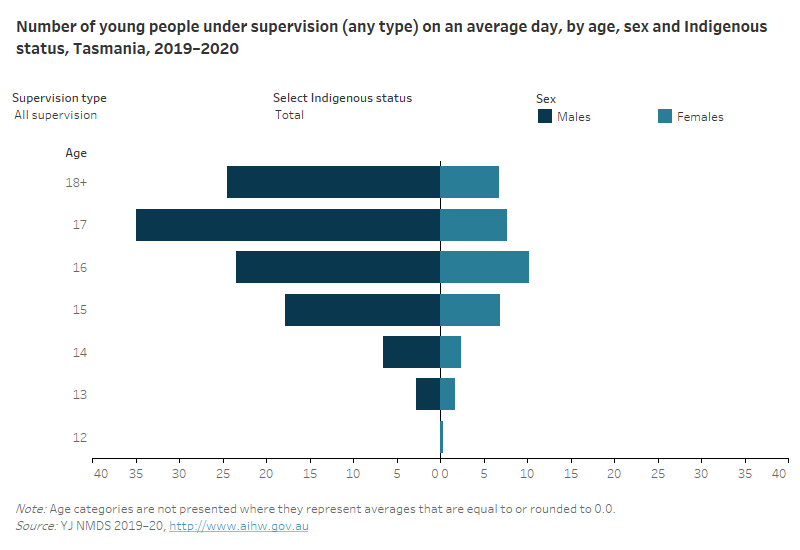Tasmania
Quick facts
On an average day in 2019–20, in Tasmania:
- 146 young people aged 10 and over were under youth justice supervision
- 22 per 10,000 young people aged 10–17 were under supervision
- Indigenous young people were almost 5 times as likely as non-Indigenous young people to be under supervision.
Among those under youth justice supervision in Tasmania:
- 89% were supervised in the community, and the rest in detention
- 75% were male
- 34% of those aged 10–17 were Aboriginal or Torres Strait Islander
- 69% of young people in detention were unsentenced (awaiting the outcome of their court matter or sentencing), and the rest were serving a sentence.
Young people spent an average of about 31 weeks under supervision during the year.
Over the 5 years to 2019–20, the number of young people under supervision on an average day rose by 3.3%, while the rate for those aged 10–17 increased from 17 to 22 per 10,000.
Box: Impact of COVID-19 on youth justice data
This report includes data from the COVID-19 period, between March and June 2020. However, more data is required to determine the impact of COVID-19 on the youth justice system.
Number and rate
On an average day in 2019–20, in Tasmania:
- 146 young people aged 10 and over were under youth justice supervision
- 9 in 10 (89%) were supervised in the community, and the rest (11%) in detention
- the rate of supervision was 22 per 10,000 young people aged 10–17
- 20 per 10,000 young people aged 10–17 were under community-based supervision, and 2.8 per 10,000 were in detention.
Age and sex
On an average day in 2019–20, in Tasmania:
- 79% of those under supervision were aged 10–17, and the rest were 18 and over
- 75% of those under supervision were male
- males under supervision were most likely to be aged 17, while females were most likely to be aged 16.

Box: Updated age calculation on an average day
For 2019–20, the age calculation for the average daily population has been changed. Age is now calculated based on the age a young person is each day that they are under supervision. If a young person changes age during a period of supervision, then the average daily number under supervision will reflect this. Due to this change in methodology, average daily data with an age selection or breakdown will not be comparable to previous Youth justice in Australia releases.
Aboriginal and Torres Strait Islander young people
On an average day in 2019–20, in Tasmania:
- Indigenous young people made up 10% of those aged 10–17 in the general population, but 34% of those of the same age under supervision
- Indigenous young people aged 10–17 were almost 5 times as likely as non-Indigenous young people to be under supervision (74 per 10,000 compared with 15 per 10,000).
Time under supervision
In 2019–20, in Tasmania:
- the median duration of individual periods of supervision that were completed during the year was 365 days (52 weeks)
- when all time spent under supervision during the year is considered, young people spent an average of 220 days (about 31 weeks) under supervision.
Sentenced and unsentenced detention
On an average day in 2019–20, in Tasmania:
- 69% of young people in detention were unsentenced—that is, they were awaiting the outcome of their court matter, or had been found guilty and were awaiting sentencing
- over 2 in 5 (46%) young people in detention were serving a sentence (proportions might not sum to 100% because some young people were in sentenced and unsentenced detention on the same day).
Trends to 2019–20
Over the 5 years to 2019–20, on an average day in Tasmania:
- the number of young people under supervision rose by 3.3% (from 141 in 2015–16 to 146 in 2019–20), while the rate increased from 17 to 22 per 10,000 young people aged 10–17
- in community-based supervision, the number fluctuated between 123 and 144, while the rate increased from 15 to 20 per 10,000
- in detention, the number rose by 68%, and the rate increased from 1.4 to 2.8 per 10,000.

More information
For more information see Youth Justice.



